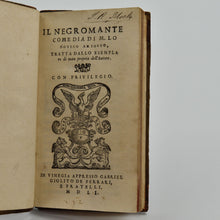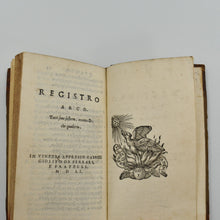ARIOSTO, Ludovico. Il Negromante, comedia … tratta dallo esemplare di man propria dell’Autore. Venice: Gabriele Giolito de’ Ferrari. 1551.
12mo. Early 19th-century English half calf, roll-tooled in blind, spine with raised bands, tooled in blind and lettered directly in gilt; ff. 43, [1]; woodcut printer’s device to recto of first and final leaf, woodcut initials and ornaments; extremities a little worn, hinges cracked but hold firm, head of spine chipped; a few small stains but otherwise a very good, crisp copy; armorial bookplate of Samuel R. Block to front pastedown, his ownership signature in ink to title page.
First edition, the final and definitive “Ferrara” version, of Ariosto’s first comedy in verse and his “most problematic work for the stage” (Portner).
Ludovico Ariosto (1474-1533), best known today for his epic poem Orlando furioso, was also the author of five comedies. Following the successful staging of his comedy I Suppositi in the Vatican during the 1519 Carnival, he was commissioned by Pope Leo X to write a new play. Il Negromante (The Necromancer) was sent to Rome on 16 January 1520, however its planned Roman premiere never took place; the pope, instead, chose to stage Niccolò Machiavelli’s La Mandragola. The most likely reason for the play’s cancellation was its veiled yet pointed critique of Leo X and the Vatican, particularly regarding the sale of indulgences and clerical corruption. While Ariosto’s wit was tolerated in other settings, a performance of Il Negromante in the heart of the papal court – just three years after Martin Luther’s Ninety-five Theses – may have been considered too unsettling.
In the play, the charlatan Mastro Iachelino, the so-called “Necromancer”, is summoned to cure the supposed impotence of Clintio through his claimed magic arts. Clintio, a newlywed, is in fact secretly married to another woman, Lavinia. Seeking to escape the marriage imposed on him by his foster father, Massimo, he later turns to Iachelino himself, hoping to maintain the illusion of impotence. Meanwhile, another young man, Camillo, also seeks the Necromancer’s help, hoping to win the favour of Emilia, the bride involved in the unconsummated marriage with Clintio.
Two versions of the comedy exist: one “for Rome” and one “for Ferrara”. The first, sent to the papal court in 1520, was published posthumously in Venice in 1535. The second, revised for the Ferrarese court around 1528, was also published posthumously in this edition, printed by Gabriele Giolito de’ Ferrari in 1551 and dedicated by the editor Lodovico Dolce (c. 1508-1568) to Giovan Vincenzo Vigliona. Dolce based his edition on the original manuscript, which he had acquired from Ariosto’s heirs.
Adams A-1655; Edit16 CNCE 2665; Agnelli-Ravegnani, Annali delle Edizioni Ariostee, II, p. 123 (“of considerable rarity, like all Giolito editions, and of undeniable importance regarding the text of Il Negromante, inasmuch as it provides us with a version of the comedy not merely corrected but entirely rewritten by the poet”, transl.). See Portner, “A Non-Performance of Il Negromante”, Italica, 59/4, Renaissance (Winter, 1982), pp. 316-329.
#2121709






